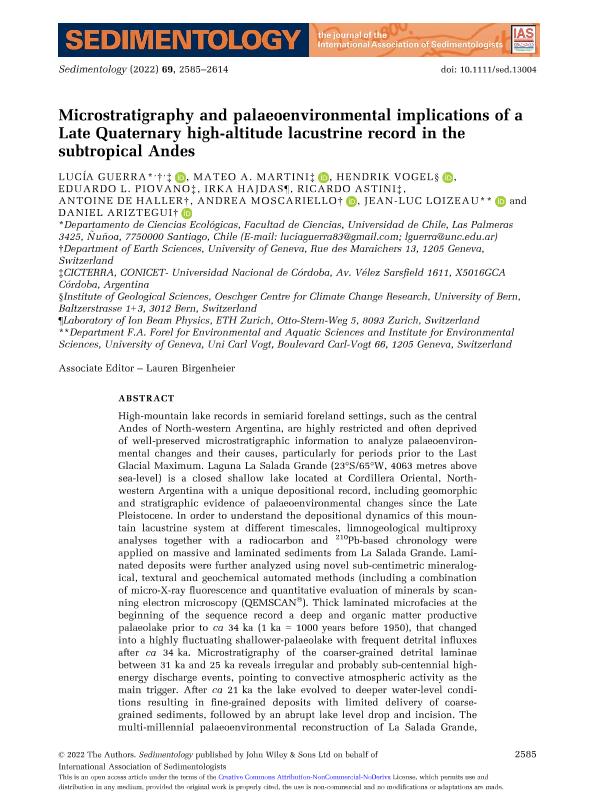Artículo
Microstratigraphy and palaeoenvironmental implications of a Late Quaternary high-altitude lacustrine record in the subtropical Andes
Guerra, Lucía ; Martini, Mateo Antonio
; Martini, Mateo Antonio ; Vogel, Hendrik; Piovano, Eduardo Luis
; Vogel, Hendrik; Piovano, Eduardo Luis ; Hajdas, Irka; Astini, Ricardo Alfredo
; Hajdas, Irka; Astini, Ricardo Alfredo ; De Haller, Antoine; Moscariello, Andrea; Loizeau, Jean-Luc; Ariztegui, Daniel
; De Haller, Antoine; Moscariello, Andrea; Loizeau, Jean-Luc; Ariztegui, Daniel
 ; Martini, Mateo Antonio
; Martini, Mateo Antonio ; Vogel, Hendrik; Piovano, Eduardo Luis
; Vogel, Hendrik; Piovano, Eduardo Luis ; Hajdas, Irka; Astini, Ricardo Alfredo
; Hajdas, Irka; Astini, Ricardo Alfredo ; De Haller, Antoine; Moscariello, Andrea; Loizeau, Jean-Luc; Ariztegui, Daniel
; De Haller, Antoine; Moscariello, Andrea; Loizeau, Jean-Luc; Ariztegui, Daniel
Fecha de publicación:
05/2022
Editorial:
Wiley Blackwell Publishing, Inc
Revista:
Sedimentology
ISSN:
0037-0746
Idioma:
Inglés
Tipo de recurso:
Artículo publicado
Clasificación temática:
Resumen
High-mountain lake records in semiarid foreland settings, such as the central Andes of North-western Argentina, are highly restricted and often deprived of well-preserved microstratigraphic information to analyze palaeoenvironmental changes and their causes, particularly for periods prior to the Last Glacial Maximum. Laguna La Salada Grande (23°S/65°W, 4063 metres above sea-level) is a closed shallow lake located at Cordillera Oriental, North-western Argentina with a unique depositional record, including geomorphic and stratigraphic evidence of palaeoenvironmental changes since the Late Pleistocene. In order to understand the depositional dynamics of this mountain lacustrine system at different timescales, limnogeological multiproxy analyses together with a radiocarbon and 210Pb-based chronology were applied on massive and laminated sediments from La Salada Grande. Laminated deposits were further analyzed using novel sub-centimetric mineralogical, textural and geochemical automated methods (including a combination of micro-X-ray fluorescence and quantitative evaluation of minerals by scanning electron microscopy (QEMSCAN®). Thick laminated microfacies at the beginning of the sequence record a deep and organic matter productive palaeolake prior to ca 34 ka (1 ka = 1000 years before 1950), that changed into a highly fluctuating shallower-palaeolake with frequent detrital influxes after ca 34 ka. Microstratigraphy of the coarser-grained detrital laminae between 31 ka and 25 ka reveals irregular and probably sub-centennial high-energy discharge events, pointing to convective atmospheric activity as the main trigger. After ca 21 ka the lake evolved to deeper water-level conditions resulting in fine-grained deposits with limited delivery of coarse-grained sediments, followed by an abrupt lake level drop and incision. The multi-millennial palaeoenvironmental reconstruction of La Salada Grande, and its correlation with other palaeoclimate records, shows a close link between the lacustrine depositional processes and palaeoclimate changes associated with the South American summer monsoon dynamics. This multifocal research in such an understudied environment provides key knowledge about lacustrine functioning and discharge events−climate interactions of mountain lakes of semi-arid climates.
Archivos asociados
Licencia
Identificadores
Colecciones
Articulos(CICTERRA)
Articulos de CENTRO DE INVEST.EN CS.DE LA TIERRA
Articulos de CENTRO DE INVEST.EN CS.DE LA TIERRA
Citación
Guerra, Lucía; Martini, Mateo Antonio; Vogel, Hendrik; Piovano, Eduardo Luis; Hajdas, Irka; et al.; Microstratigraphy and palaeoenvironmental implications of a Late Quaternary high-altitude lacustrine record in the subtropical Andes; Wiley Blackwell Publishing, Inc; Sedimentology; 69; 6; 5-2022; 2585-2614
Compartir
Altmétricas



